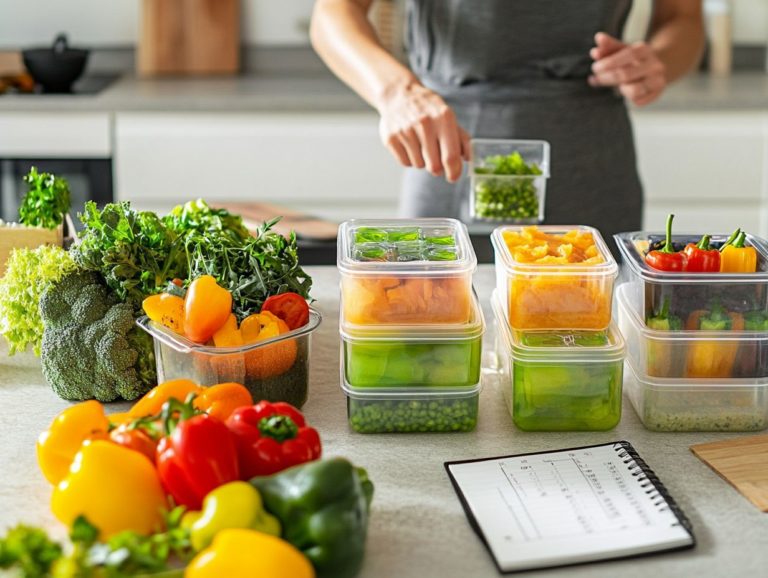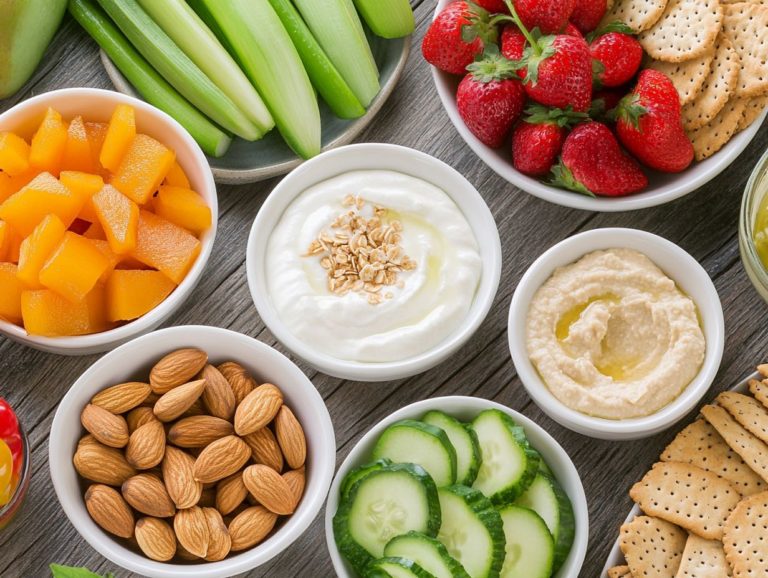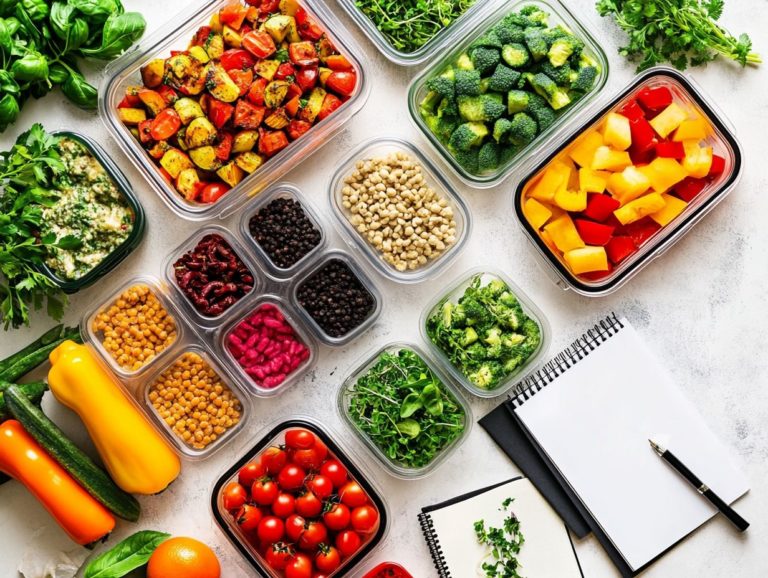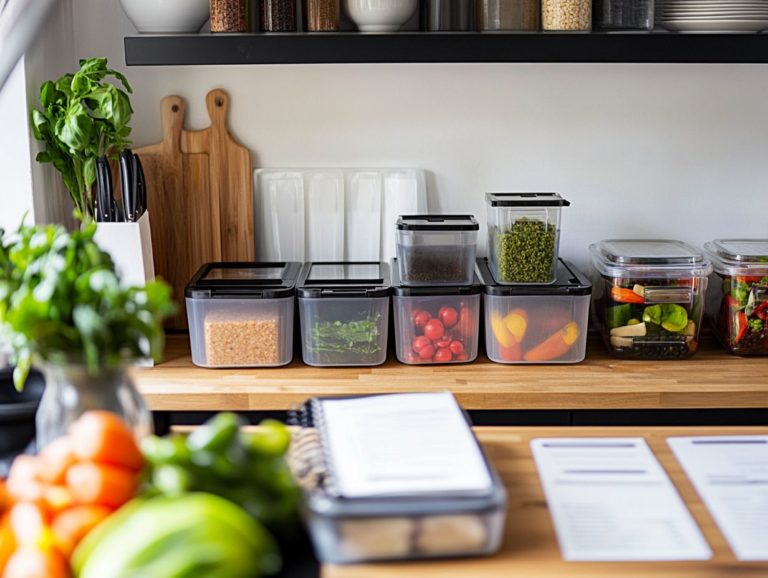How to Create a 30-Day Meal Plan
Are you weary of the daily dilemma of what to eat? A 30-day meal plan can revolutionize your approach to nutrition and time management, simplifying your life while enhancing your health.
This article guides you through the process of creating a personalized meal plan by evaluating your dietary needs and goals. You ll discover valuable tools and resources, along with expert tips to help you stay on track. Plus, a sample meal plan brimming with delicious ideas awaits you. You will also uncover how to adapt your plan for lasting success. Now’s the time to take charge of your meals and transform your eating habits!
Contents
- Key Takeaways:
- Benefits of Having a 30-Day Meal Plan
- Creating a Personalized Meal Plan
- Meal Planning Tools and Resources
- Tips for Sticking to Your Meal Plan
- Sample 30-Day Meal Plan
- Modifying and Adjusting Your Meal Plan
- Frequently Asked Questions
- What is a 30-day meal plan and why is it useful?
- How do I start creating a 30-day meal plan?
- How do I stay organized while following a 30-day meal plan?
- Can I still have variety in my meals while following a 30-day meal plan?
- What are some tips for sticking to a 30-day meal plan?
- How can I adapt a 30-day meal plan to my specific dietary needs?
Key Takeaways:
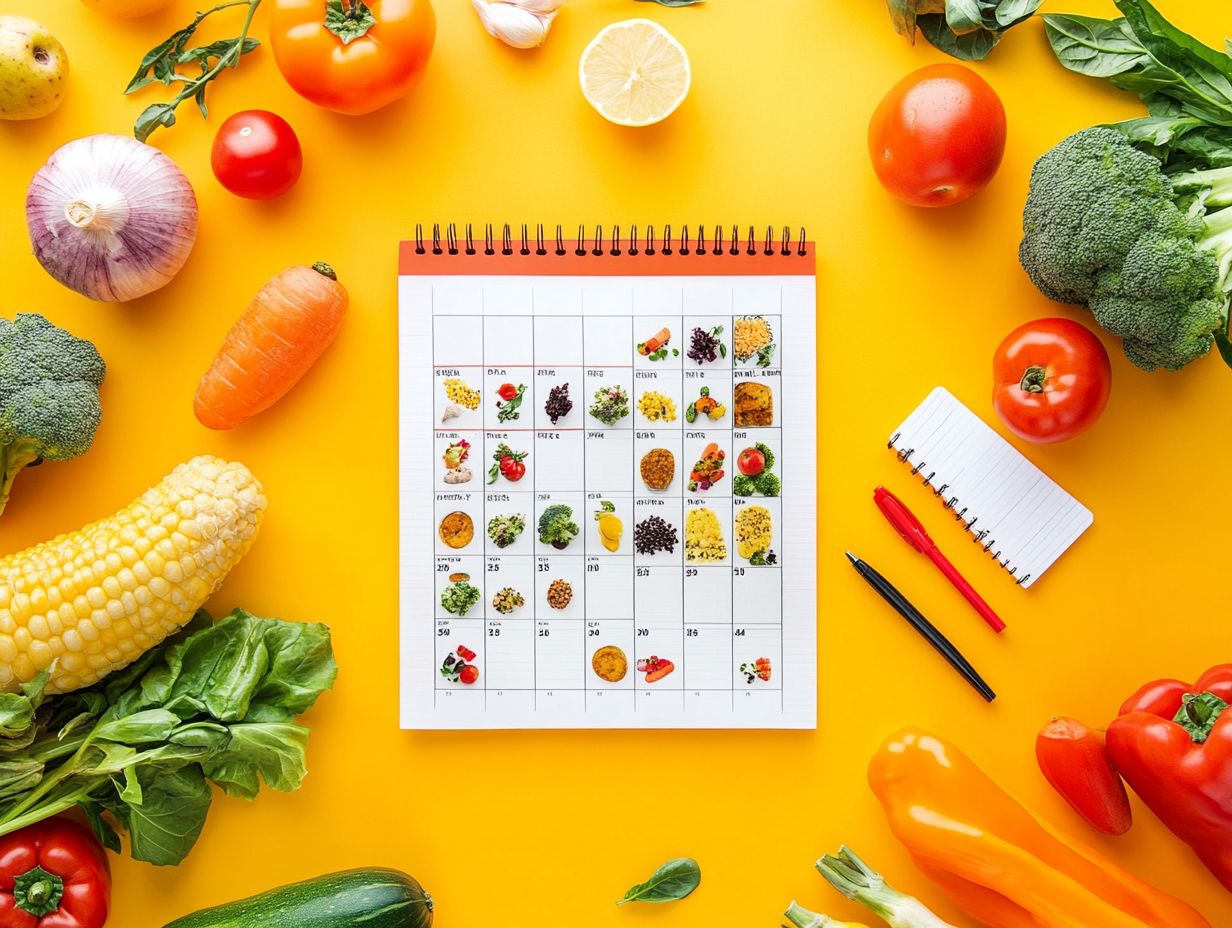
- A 30-day meal plan can improve nutrition and time management by ensuring balanced meals and preventing last-minute decisions.
- To create a personalized meal plan, assess your dietary needs and goals to choose the right types and amounts of food.
- Use meal planning tools and resources such as apps and websites to simplify the process and stay organized.
Benefits of Having a 30-Day Meal Plan
Embracing a 30-day meal plan brings a wealth of benefits, including enhanced nutrition and improved time management. By implementing a structured approach to meal planning, you can align your meals with your health objectives, whether that’s shedding a few pounds or managing food sensitivities. To get started, check out this guide on how to create a superfood meal plan. A thoughtfully crafted meal plan minimizes food waste. It also simplifies your grocery shopping experience and elevates family meals, ultimately contributing to your overall well-being.
Improved Nutrition and Time Management
Effective meal planning enhances nutrition and time management. It allows you to enjoy healthy meals while saving time in the kitchen.
By thoughtfully organizing your meals for the week, you can easily choose wholesome ingredients that cater to your varied dietary needs whether that’s gluten-free, vegan, or low-carb. This mindful approach not only enables you to make informed food choices but also significantly reduces the chances of impulsive, unhealthy eating.
For a time-saving strategy, consider batch cooking staple items like quinoa or roasted vegetables. These can be effortlessly incorporated into various meals throughout the week. Picture a versatile stir-fry using a delightful mix of proteins and seasonal veggies, or indulging in overnight oats as a quick, nutritious breakfast.
By planning ahead, you can create meals that align perfectly with your health goals, all without sacrificing flavor or precious time.
Creating a Personalized Meal Plan
Crafting a personalized meal plan tailored to your unique dietary needs and preferences can significantly elevate your overall health and well-being. This journey starts with a deep understanding of your food sensitivities and tastes. You might explore how to customize your meal plan, which may involve embracing a Whole30 meal plan that focuses on whole foods and eliminates sugar and grains, or reimagining traditional recipes to align with your lifestyle.
Assessing Dietary Needs and Goals
Assessing your dietary needs and goals is an essential first step in crafting an effective meal plan, especially if you have specific food sensitivities or are aiming for weight loss. This initial evaluation enables you to customize your nutrition in a way that aligns seamlessly with your health objectives.
Consulting with experienced dietitians can offer you invaluable insights into personalized dietary strategies, helping you identify problematic foods and explore suitable alternatives. These professionals can also assist you in setting realistic dietary goals that are both achievable and sustainable. Implementing effective meal planning strategies, such as batch cooking and utilizing food journals, can be instrumental in navigating dietary challenges.
This approach promotes adherence and encourages mindful choices that lead to lasting health benefits.
Start your meal planning journey today for a healthier tomorrow!
Meal Planning Tools and Resources
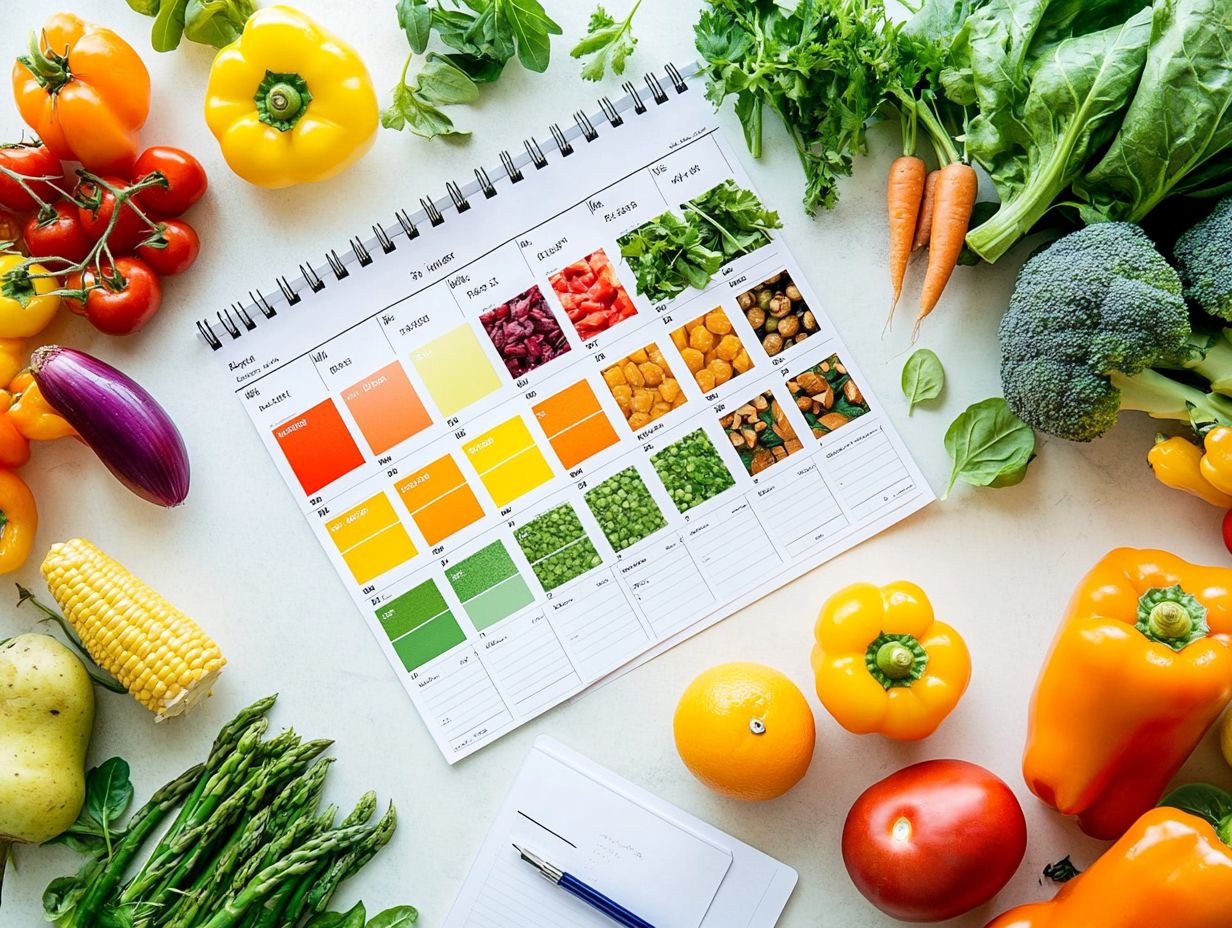
By utilizing meal planning tools and resources, you can streamline your meal prep efforts. This makes it significantly easier to adhere to your healthy eating goals.
Whether it s apps designed for grocery shopping or carefully crafted meal planning templates, these resources can elevate your experience and assist you in achieving your nutritional targets.
Apps, Websites, and Other Helpful Tools
Want to simplify your cooking? You have a wealth of apps and websites at your fingertips! They can elevate your meal planning game with features like grocery lists and recipe inspiration.
These digital tools streamline the process of organizing meals. They offer customizable options catering to your unique dietary needs.
You can easily explore a variety of recipes tailored to specific cuisines or nutritional requirements. This makes it a breeze to keep your meals exciting and fresh.
Many of these platforms even integrate grocery shopping features that automatically generate lists based on the recipes you select. This saves you precious time and minimizes the chances of forgetting essential ingredients.
With their user-friendly interfaces, these meal planning solutions enhance your cooking habits. They foster healthier eating habits, ultimately transforming the way you prepare food.
Tips for Sticking to Your Meal Plan
Adhering to your meal plan can present challenges. However, incorporating practical strategies can improve your cooking habits and pave the way for long-term success.
By preparing simple recipes in advance and creatively repurposing leftovers, you can maintain your focus while delighting diverse tastes when cooking for others.
Strategies for Overcoming Challenges
Overcoming challenges in meal planning requires a blend of strategic thinking and practical cooking tips. This helps minimize food waste while ensuring your family meals are enjoyable.
One effective method is to plan your meals around ingredients that are on sale or in season. This not only saves you money but also encourages the use of fresh produce.
Incorporating versatile recipes that can be easily adjusted allows for creative use of leftovers. For example, you can blend leftover vegetables into soups or repurpose grains into vibrant salads.
These adaptations promote sustainability and keep your family meals exciting!
Sample 30-Day Meal Plan
A carefully crafted 30-day meal plan serves as a treasure trove of inspiration for your meal planning efforts. By incorporating a diverse array of recipes and meal types, think delightful breakfast bowls, delectable dinner dishes, and effortless lunches, you can streamline your daily routine. For further guidance, check out how to create a seasonal meal plan.
Breakfast, Lunch, Dinner, and Snack Ideas
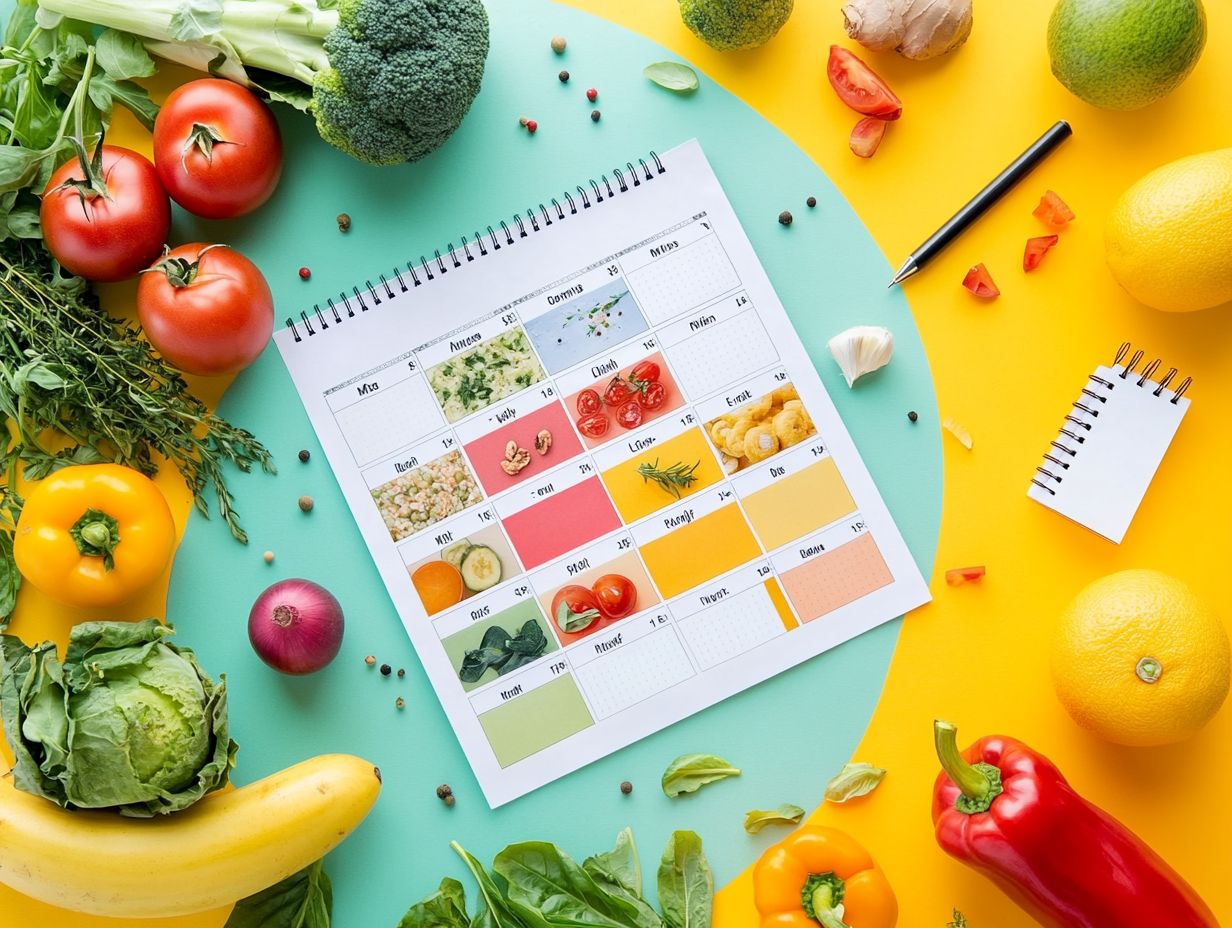
It’s essential to have enticing ideas for breakfast, lunch, dinner, and snacks. This variety not only brings joy to your meals but also ensures a balanced approach to nutrition.
- For breakfast, enjoy refreshing smoothie bowls with seasonal berries or hearty oatmeal topped with sliced peaches and a drizzle of honey.
- Lunchtime can be just as delightful with vibrant sushi rolls stuffed with summer vegetables or a quinoa salad bursting with fresh herbs, cucumbers, and ripe tomatoes.
- In the evening, elevate your dinner with grilled shrimp skewers or a light zucchini and tomato pasta that celebrates summer produce.
Embracing this diversity will transform your dining experience into a flavorful adventure!
Modifying and Adjusting Your Meal Plan
Adjusting and refining your meal plan is crucial for long-term success, especially as your dietary needs evolve.
Regularly assess your recipes. Make mindful adjustments to keep your cooking routine flexible and enjoyable.
How to Adapt Your Plan for Long-Term Use
Adapting your meal plan for the long haul means integrating healthy dishes that resonate with your preferences and those of anyone else you may be cooking for.
To keep your meal plan vibrant and exciting, explore various cuisines that bring new flavors and textures to your table. For example, swap out traditional ingredients for healthier alternatives like using zucchini noodles instead of pasta or incorporating cauliflower rice for a low-carb twist.
Mix up your cooking methods whether it s grilling, roasting, or saut ing to transform the overall taste of your dishes. Involve everyone in the cooking process by gathering their input to make meals more enjoyable, ensuring that the choices cater to diverse tastes and dietary needs.
Frequently Asked Questions
What is a 30-day meal plan and why is it useful?
A 30-day meal plan is a pre-planned menu for a month’s worth of meals. It can help you achieve health and fitness goals while learning how to revamp your meal plan monthly, saving time and money, and reducing stress around meal planning.
How do I start creating a 30-day meal plan?
First, determine your goals and dietary restrictions. Create a list of your favorite meals, and aim for a balance of protein, carbohydrates, and healthy fats. Use reference data to ensure you meet your nutritional needs.

How do I stay organized while following a 30-day meal plan?
Creating a weekly or daily meal schedule can make a big difference! Prepare meals and snacks in advance to save time and ensure you have all necessary ingredients on hand. Use meal planning apps or templates to stay organized.
Can I still have variety in my meals while following a 30-day meal plan?
Absolutely! Mix and match different ingredients and flavors to create new dishes, or try out new recipes. Just keep track of your portions and adhere to your plan’s guidelines.
What are some tips for sticking to a 30-day meal plan?
Set realistic goals, stay motivated, and allow for flexibility. Don t be too hard on yourself if you deviate from the plan occasionally. Involve others in your meal planning journey for support and accountability.
How can I adapt a 30-day meal plan to my specific dietary needs?
If you have dietary restrictions or preferences, modify the meals in your plan accordingly. Consult a nutritionist or do research to ensure you meet your nutritional needs while staying within your dietary guidelines.

